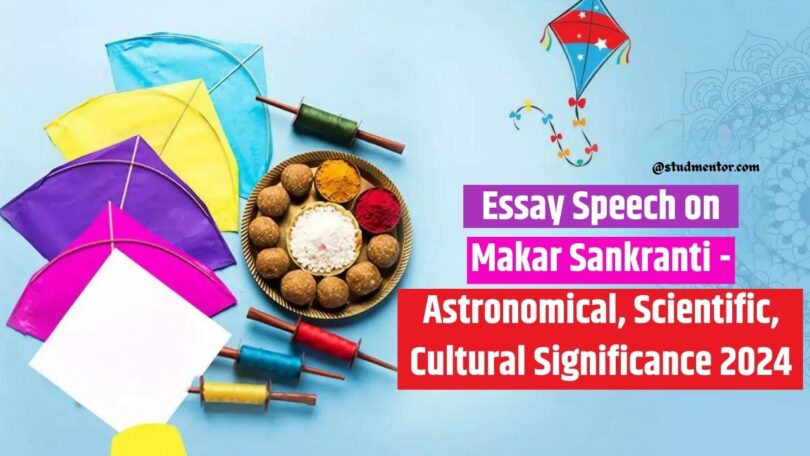Are you searching for – Essay Speech on Makar Sankranti – Astronomical, Scientific, Cultural Significance 2024
Then you are at Right Place.
Are you searching for – Essay Speech on Makar Sankranti – Astronomical, Scientific, Cultural Significance 2024
Essay Speech on Makar Sankranti – Astronomical, Scientific, Cultural Significance 2024
Makar Sankranti is a festival that marks the transition of the sun into the zodiac sign of Makara (Capricorn) on its celestial path, and it usually falls on January 14th or 15th. Astronomically, Makar Sankranti marks the gradual increase in the length of daylight hours in the northern hemisphere, following the winter solstice.
Astronomical and Scientific Significance
The astronomical aspect of Makar Sankranti aligns with the seasonal changes, emphasizing the cyclical nature of time and the interconnectedness of celestial events with agricultural cycles, which is deeply rooted in the cultural fabric of India. The ending of the winter solstice holds scientific importance due to its role in the Earth’s axial tilt and its relationship with the length of daylight hours in different hemispheres.
As the Earth orbits the sun, the tilt of its axis causes the changing seasons. The end of them winter solstice signifies a turning point when the Northern Hemisphere starts tilting back towards the sun. This gradual shift results in an increase in daylight hours and a decrease in nighttime hours in the Northern Hemisphere.
The scientific significance lies in the gradual lengthening of daylight hours following the winter solstice. As the days become longer, the amount of sunlight reaching various regions increases, initiating changes in temperature and weather patterns. This change in sunlight exposure plays a crucial role in various natural processes.
Increased sunlight post-solstice gradually raises temperatures, initiating the thaw of snow and ice, heralding the arrival of spring. Longer daylight hours trigger transformations in both flora and fauna, influencing activities like flowering, migration, and breeding cycles. In agricultural regions, this transition marks the preparation for harvesting seasons, leveraging abundant sunlight for crop growth. Moreover, the extended daylight post-solstice can impact human well-being, affecting mood, energy levels, and daily routines due to heightened exposure to sunlight.
Cultural Significance
The festival holds significance because it heralds the arrival of spring, which traditionally symbolizes new beginnings, prosperity, and the onset of the harvest season. It’s considered an auspicious time for spiritual practices and rituals, especially bathing in holy rivers like the Ganges, as it’s believed to cleanse one’s sins and bring blessings.
Makar Sankranti is primarily a harvest festival. It is a time when farmers express gratitude for a good harvest and pray for prosperity in the coming months. The festival holds cultural significance in various states of India, and it is celebrated with different names and customs. Kite flying is a popular activity during this time, particularly in states like Gujarat and Rajasthan, where colourful kites fill the sky, symbolizing joy and the arrival of spring. Lighting a bonfire is a central part of Lohri celebrations in Punjab which is similar to Sankranti. People gather around the bonfire, offer prayers, sing traditional songs, and perform folk dances like Bhangra and Giddha. It’s a time for communities to come together, share sweets like rewari, gajak, and popcorn, and exchange good wishes. Lohri transcends religious and social barriers, fostering unity among people. It’s a festival that brings together families, friends, and neighbours to celebrate the collective joy of the harvest season. Lohri transcends religious and social barriers, fostering unity among people. It’s a festival that brings together families, friends, and neighbours to celebrate the collective joy of the harvest season.
Pongal in Tamil Nadu is a four-day long thanksgiving festival dedicated to the sun and cattle, thanking them for their contribution to a successful harvest. The first day, Bhogi Pongal, involves cleaning homes and discarding old items to signify a new beginning. The second day, Surya Pongal, involves boiling freshly harvested rice with milk and jaggery, symbolizing abundance and prosperity. The festival emphasizes unity and the renewal of relationships. Families and friends come together to celebrate, exchange gifts, and share traditional foods. It’s also a time for cultural performances, music, and dance, strengthening community bonds.
India’s Radiant Triumph in Solar Endeavours
India’s Solar Mission Aditya, named after the Sun, exemplifies the nation’s dedication to harnessing solar energy as a pivotal component of its energy strategy. Aditya is an ambitious initiative that aligns with India’s broader goal of promoting renewable energy sources, particularly solar power. The Aditya Solar Mission aims to further enhance the deployment of solar technologies in the country. The mission focuses on advancing research and development in solar energy, emphasizing innovations to increase efficiency and reduce costs.
Fusion of Makar Sankranti and Solar Science for Educational Purposes
Leveraging Makar Sankranti as an educational platform can enlighten students about solar science and the Earth-Sun relationship, fostering curiosity about India’s solar exploration endeavours through discussions tied to the Aaditya mission. Makar Sankranti’s celebration correlates with scientific insights into the sun’s movement, energy, and its agricultural implications, mirroring the Aaditya mission’s study of the Sun’s corona and its impact on Earth’s climate and technology. Suggested activities that may be undertaken in school:
Workshops and Seminars
Conduct workshops elucidating the astronomical significance of these festivals, elucidating the solar science behind these celebrations. Invite scholars and experts to engage students in discussions and presentations.
Cultural Programs
Organize cultural programs where students can actively participate by showcasing traditional dances, songs, and plays associated with these festivals, incorporating the scientific aspect wherever feasible.
Art and Craft Activities
Encourage art and craft sessions where students can create traditional crafts related to these festivals, accompanied by discussions on their significance in relation to solar movem.
Essay Writing Competitions
Encourage students to participate in essay writing themed around the Sun, Makar Sankranti, and the achievements of the Aaditya mission. This encourages creativity while reinforcing their understanding of these concepts.
Thanks to All Beloved Readers.

